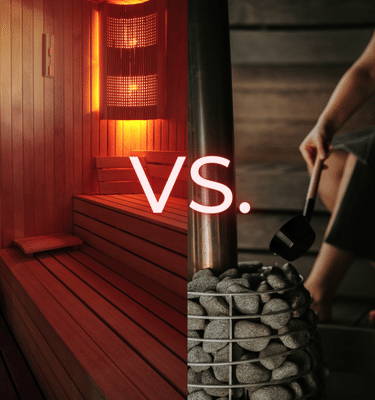What is the Difference Between Traditional and Infrared Saunas?
What is the Difference Between Traditional and Infrared Saunas?

February 8th, 2024 | Heat Therapy
Your Guide to Understanding Traditional vs Infrared Saunas
The use of saunas for health and wellness benefits dates back to thousands of years ago. With harsh conditions and hard work, the Finnish used the traditional sauna as a place to ease aching muscles and relax both their bodies and minds. Interestingly, saunas are used for similar reasons today. It’s thought regular sauna bathing can help detoxify the body, boost metabolism, enhance weight loss efforts, improve blood flow, reduce pain, improve heart health, and more1!
However, there is more than one type of sauna to choose from—including traditional and infrared saunas. So, how do you know which one is best for you? What is the difference between traditional and infrared saunas?

The Difference Between Traditional and Infrared Saunas
The key difference between the traditional and infrared saunas is how they heat up the body. A traditional sauna first heats the air, which then heats the body. An infrared sauna, in contrast, uses infrared light to penetrate the skin and heat the body directly. All of this means that infrared saunas actually use less heat to achieve similar health benefits. But let’s take a closer look!
Heat Generation
In a traditional sauna, there is one heater. This heater heats the air, which warms the person in the sauna. This sauna is usually made of wood. Yet, the heater usually contains rocks, which are heated via fire or electrical means. Water is poured on the rocks, creating steam and heat. Often, it takes about 30 minutes to heat up a traditional sauna.
In an infrared sauna, infrared has various lights that help create heat, which directly penetrate the body. It only takes about 15 minutes for this type of sauna to heat up.
Temperature
Traditional saunas tend to get much hotter, reaching up to 180 degrees Fahrenheit, which helps promote a good sweat and associated benefits. Infrared saunas often heat up to around 140 degrees. This is important to note since many people can feel very uncomfortable in really hot and wet environments, which may mean infrared saunas are a better choice.
Health Benefits
Both infrared and traditional saunas promote relaxation benefits and help to reduce stress. Since they both also promote sweating, they also increase circulation, weight reduction, skin health, and detoxification benefits which occur with sweat. In particular, studies show that sweat promotes the detoxification of heavy metals, like copper, mercury, lead, and nickel2.
Studies have further shown how both types of saunas help reduce one’s risk of cardiovascular disease1,3. Both also help improve mental health and mood. Yet, infrared saunas are shown to have a greater impact on chronic pain and fatigue4.
Costs
Since the infrared sauna takes less time to heat up, it, undeniably, saves on energy costs when compared to electric powered traditional saunas. Individuals who use fire to heat traditional saunas, can also significantly reduce costs.
At the same time, free-standing infrared saunas have the same cost benefits as infrared sauna blankets, with infrared saunas blanket also using less electricity (and they also take up far less space in your house and home!).
Maintenance
Most saunas are fairly low maintenance. However, if you desire the least maintenance possible, an infrared sauna (or infrared sauna blanket) is it. An infrared sauna is a “dry sauna,” meaning your sweat is the only moisture that may need cleaning. Meanwhile, with a traditional sauna, a wet heat is produced in the air, which means it requires much more maintenance to prevent mold or mildew.
If you want the ultimate low maintenance sauna experience, the top spot goes to the infrared sauna blanket. This only requires a quick spray and wipe after use and before storing it away.
Experience
Ultimately, this may come down to a personal preference. If you prefer short and sweet sauna sessions (but also like it hot!), traditional saunas are a good choice. If you prefer a dry sauna and longer sessions, an infrared sauna might be more suitable for you. There’s also the option of an infrared sauna blanket (more on this below).
The Benefits of an Infrared Sauna Blanket vs a Free Standing Infrared Sauna
An infrared sauna blanket won’t take up any room in your home or outdoor space, unlike a free-standing traditional or infrared sauna structure. It also allows you to relax anywhere you like, including the couch while you watch your favorite TV show or read your favorite book.
In fact, an infrared sauna blanket, such as the HEALiX Sauna Blanket, can be a great option for individuals who have a tighter budget and less space, yet who still want to reap the benefits of sauna therapy. Determine what works best for your lifestyle and go from there! When it comes down to it, regular sauna therapy might be just what you need to take your wellness regime up a notch.



